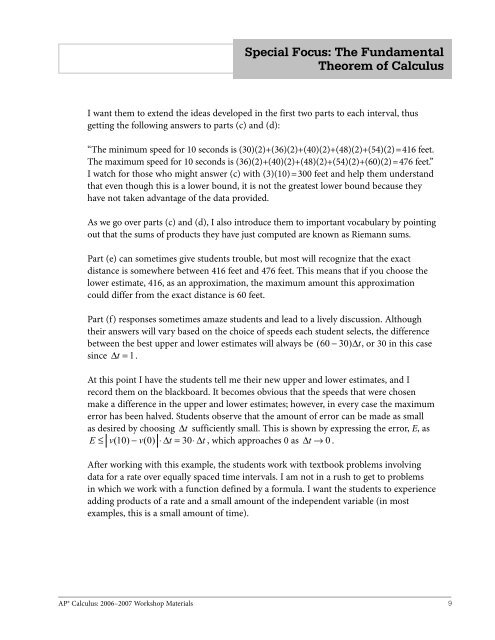AP Calculus
Calculus_SF_Theorem
Calculus_SF_Theorem
You also want an ePaper? Increase the reach of your titles
YUMPU automatically turns print PDFs into web optimized ePapers that Google loves.
Special Focus: The Fundamental<br />
Theorem of <strong>Calculus</strong><br />
I want them to extend the ideas developed in the first two parts to each interval, thus<br />
getting the following answers to parts (c) and (d):<br />
“The minimum speed for 10 seconds is (30)(2)+(36)(2)+(40)(2)+(48)(2)+(54)(2)=416 feet.<br />
The maximum speed for 10 seconds is (36)(2)+(40)(2)+(48)(2)+(54)(2)+(60)(2)=476 feet.”<br />
I watch for those who might answer (c) with (3)(10)=300 feet and help them understand<br />
that even though this is a lower bound, it is not the greatest lower bound because they<br />
have not taken advantage of the data provided.<br />
As we go over parts (c) and (d), I also introduce them to important vocabulary by pointing<br />
out that the sums of products they have just computed are known as Riemann sums.<br />
Part (e) can sometimes give students trouble, but most will recognize that the exact<br />
distance is somewhere between 416 feet and 476 feet. This means that if you choose the<br />
lower estimate, 416, as an approximation, the maximum amount this approximation<br />
could differ from the exact distance is 60 feet.<br />
Part (f) responses sometimes amaze students and lead to a lively discussion. Although<br />
their answers will vary based on the choice of speeds each student selects, the difference<br />
between the best upper and lower estimates will always be ( 60 − 30)<br />
∆t, or 30 in this case<br />
since ∆t = 1.<br />
At this point I have the students tell me their new upper and lower estimates, and I<br />
record them on the blackboard. It becomes obvious that the speeds that were chosen<br />
make a difference in the upper and lower estimates; however, in every case the maximum<br />
error has been halved. Students observe that the amount of error can be made as small<br />
as desired by choosing ∆t sufficiently small. This is shown by expressing the error, E, as<br />
E ≤ v( 10) − v( 0)<br />
⋅ ∆t = 30⋅<br />
∆ t , which approaches 0 as ∆t → 0 .<br />
After working with this example, the students work with textbook problems involving<br />
data for a rate over equally spaced time intervals. I am not in a rush to get to problems<br />
in which we work with a function defined by a formula. I want the students to experience<br />
adding products of a rate and a small amount of the independent variable (in most<br />
examples, this is a small amount of time).<br />
<strong>AP</strong>® <strong>Calculus</strong>: 2006–2007 Workshop Materials 9


